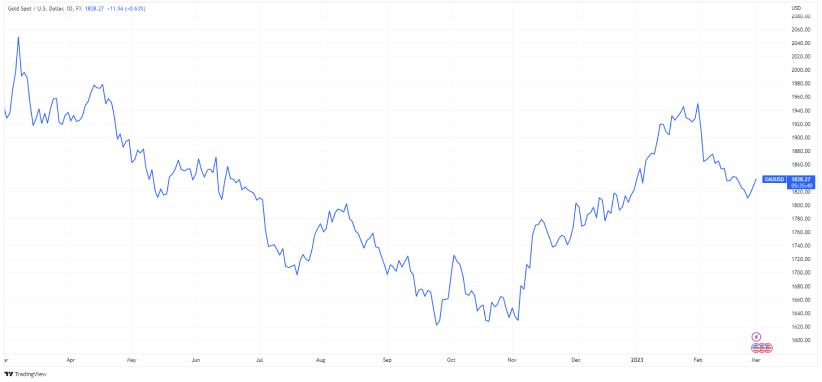After hitting a record high of over $2,000/ounce in March last year, the gold price has steadily declined. According to analysts' forecasts, the trend may soon change. Yet still, February 2023 turned out to be a lousy month for the precious metal market. Throughout the month, the XAUUSD price dipped by 5%.

Historical journey
Gold made its first appearance in Ancient Egypt at the end of the fifth millennium BC. Throughout many centuries, it’s been the main rate of wealth and used as a store of value. Today, this precious metal is mainly applied in industry (on a large scale in production of electronics) and, of course, in trading. As is the case with lots of other commodities, the price of gold depends on supply and demand, inflation rate, geopolitical events. But having managed to retain its worth over the years, despite economic booms and busts, gold has come to be regarded as a ‘safe haven’ asset which is a good place for investors to ‘stash’ their cash in times of economic uncertainty.
The key factor affecting the gold’s price is the US dollar. To be more specific, it’s their inverse relationship - the USD’s strength against other currencies hurts the price of gold as it becomes more expensive, and conversely, when the USD is falling in value, it fuels gold demand.
After the removal of the gold standard - a monetary system in which the basic unit of account was gold, and it was guaranteed that each unit of money issued can be exchanged for a corresponding amount of gold - gold started to be traded on the free market. Under a gold standard, the government couldn’t print money that was not backed by gold. And adoption of the Bretton Woods system overnight made the US national currency world money (before shifting to the Bretton Woods system many international contracts used the British pound for settlements).
Nowadays
The military conflict between Russia and Ukraine boosted gold prices. The closing price on February 24, 2022, hit $1,926.30. It briefly dipped in the next couple of days, but the price quickly resumed its advance. However, gold started to lose ground in mid-March as the US Federal Reserve began to take measures to combat inflation – economic events that investors can keep track of with the economic calendar. The hawkish policy of the Fed did not leave a chance for the precious metal, and it gave up its advantage to the greenback. Yet, between early November 2022 and late January 2023 it gained over 17%.
Gold may gain its momentum in 2023. Why’s that? Just look at the situation we’re in. The global economic crisis is not fading away, lots of investors fear the upcoming recession, and this is why investing in precious metals seems to be a good way to save money. Private investors are not the only ones to set their sights on gold. In order for currencies to retain their value, central banks use the purchasing of gold as a tool to show they have a physical asset to justify the valuation of their money, especially those of countries experiencing high inflation. One of the biggest buyers of gold, China, has reopened its economy and already increased its gold purchases by 32 tonnes.
Based on current data, there is reason to believe that the demand for gold will rise. However, we should not forget that one of the main factors is the geopolitical situation. Resolution of the conflict between Russia and Ukraine could help to restore economic equilibrium, but it remains to be seen.
This article was written in cooperation with TradingView
